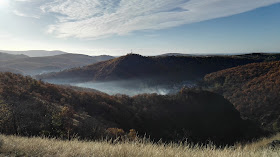Maps, guidebooks and navigation: There is a Hungarian map/guidebook in two volumes for the Kektura. If you buy it here in Germany it will cost you more than 50 EUR! I bought it, carried it on the trail - and never used it. If you still decide you want it (although all the text is in Hungarian - you can only use the maps and get an overall impression from the pictures), then buy it directly in Hungary where one book will only cost you 10 EUR. There are two German guidebooks without maps for the Eastern half of the Kektura: Budapest - Putnok and Putnok to the Slovak border. I used them, too and although I found them quite useful in times they are already a bit outdated - and you don't really need them. Why? Because first of all the waymarking of the trail is fantastic - if you don't see a blue blaze for 5 minutes you know you are off track. Secondly, OSM based maps are really all you need for navigation. I had the OSM map of Hungary on my GPS and the openandroid map for Oruxmaps on my smartphone as a back up. The latter is especially useful as it also shows the water sources in the villages.
 |
| Village services: Water, mail and telephone |
Shops: Most villages still have some sort of litte shop where you can buy basic supplies. Bigger towns have European chain discount stores like Aldi, Lidl, Tesco, Auchan. Stores open extremely early in Hungary: Village stores usually at 6 am, and even Aldi and Lidl open at 7 am. This means stores also close very early. Don't count on finding an open village store after 4 pm - and most already close at noon! Bigger shops are even open on Sundays! I hardly carried more than two days worth of food!
Food: In every shop you will find bread which is dirt cheap. Then there is usually some sort of sausage or salami and some basic cheese - also relatively cheap for Western European standards. Surprisingly Milka chocolote is ubiquitous in Hungary -and costs the same as in Germany! There are also some good packaged cookies - but the nuts section is usually not very well stocked. Dehydrated food is hard to find: Hungarian type "top ramen noodle soup" is available in most village stores but it tastes as bad as the American original and I only used it for emergencies. Town shops though stock a lot of "Knorr" packages mostly imported from Germany. The photo shows a Hungarian specialty: Turos rud - a curd filled chocolate snack that you will find in the refrigerated section of even small village stores.
 |
| Gulyas |
Accommodation: is cheap and plentyful in Hungary! Even in most small villages you will find a holiday apartment or private rooms. Unfortunately, most hosts speak Hungarian only which makes reservations by phone difficult for foreigners. The main website for private accommodation in Hungary is szallas.hu, but is in Hungarian only. They cooperate with Revngo.com which looks like a fraud website because their horrible translations - but I have booked several rooms through them and it always worked. Booking.com is another option for Hungary. Most cheap accommodation is holiday apartments or even cottages. This is usually much cheaper than a hotel room! Don't be surprised to find out that you can choose between four beds in your room! Expect to pay between 15 - 25 € for single occupancy and up to 35 € for double occupancy. Every single room I have stayed in sparling clean but don't expect modern furniture. Always carry a smart phone in Hungary. Most landlords don't live at the rental place, so you will have to send an email or a text message with your arrival date.
Dogs: When you walk through any village you will be greeted by a dog concert. Everybody in the countryside seems to have a dog. The good news though is that all these dogs are well fenced in - I encountered very few stray dogs. Although plentiful and loud, dogs are not a danger for hikers in Hungary.

Dangers and annoyances: Although hiking through Hungary is a very pleasant and relaxing experience I found two things that were a problem for me. The first one my only be a perceived but no real problem: the gypsies or Roma people! In Eastern Hungary you walk through a lot of Roma villages. I was shocked by the poverty and felt like walking through a ghetto. I must say that I was scared at some places although nothing happened - and I have not heard of any single incident involving hikers. There is a very good article about the topic on the English Kektura website! The second (and more real) problem was the mud: If it rains a lot most forest roads turn into mud slides - especially when they are harvesting trees.
Stamps: Most Hungarian hikers collect stamps along the the Kektura. You can buy a specific booklet for that and you will find the stamping places all along the trail. I didn't do it but other hikers told me that it is great fun.
Seasons: I thruhiked Kektura in October and early November because I was told that this is the best season. I had bad luck because it rained a lot and got cold very early which is unusual. I would still recommend hiking here in either spring or fall. Winter can be very cold here and summer is too hot in Hungary.
Transportation: Buses and trains get you anywhere in Hungary - and they are very cheap. I would recommend flying to Budapest and then take public transport to the place where you want to hike. Hungary is not that big and you should get to any major point along the trail in less than 5 hours.


















































